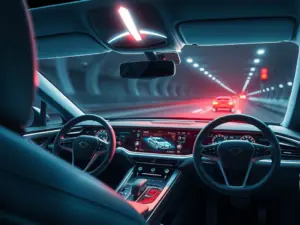Imagine you’re cruising down the highway, your hands on the wheel, but your car is quietly working alongside you, analyzing road conditions, predicting potential hazards, and making split-second decisions to keep you safe. This isn’t a scene from a sci-fi movie—it’s the reality of driving with AI co-pilots, and it’s transforming road safety as we know it.
The Rise of AI in the Driver’s Seat
Artificial Intelligence has found its way into nearly every aspect of our lives, and the automotive industry is no
exception. AI co-pilots, also known as advanced driver assistance systems (ADAS), are revolutionizing the way we interact with our vehicles and the road. These intelligent systems act as a vigilant partner, constantly monitoring the environment and assisting drivers in making safer decisions.
But what exactly are these AI co-pilots capable of? Let’s buckle up and take a closer look at the cutting-edge technologies that are making our roads safer.
The Tech Behind the Wheel
Lane Departure Warning Systems: Your Personal Line Judge
Imagine having a friend who gently nudges you when you’re drifting out of your lane. That’s essentially what lane departure warning systems do. Using cameras and sensors, these systems detect lane markings and alert drivers when they unintentionally cross them. Some advanced versions can even steer the car back into the correct lane automatically.
Real-world impact: Studies have shown that vehicles equipped with lane departure warning systems are involved in
11% fewer single-vehicle, sideswipe, and head-on crashes compared to those without.
Adaptive Cruise Control: The Smart Tailgating Prevention Tool
Remember the days of constantly adjusting your speed to maintain a safe distance from the car ahead? Adaptive cruise
control takes care of that for you. This system uses radar or cameras to maintain a preset distance from the vehicle in front, automatically adjusting your speed as needed.
Driver experience: “It’s like having a co-driver who’s always paying attention to the traffic ahead,” says Sarah, a daily commuter. “I feel much more relaxed on long drives now.”
Autonomous Emergency Braking: The Guardian Angel You Never Knew You Needed
When split seconds matter, autonomous emergency braking can be a lifesaver—literally. This system detects potential collisions and applies the brakes if the driver doesn’t respond in time.
Safety stat: Vehicles equipped with autonomous emergency braking have shown a 38% reduction in rear-end collisions, according to a study by the Insurance Institute for Highway Safety.
Collision Avoidance Systems: Your 360-Degree Safety Net
These systems use a combination of cameras, radar, and sometimes lidar to detect potential collisions from all angles.
They can warn drivers of impending danger and, in some cases, take evasive action.
Interactive element: Try a virtual demo of collision avoidance systems in action
Traffic Sign Recognition: Never Miss a Speed Limit Again
Using cameras and image processing algorithms, these systems can read and interpret road signs, displaying the
information on your dashboard. Some advanced versions can even adjust your speed automatically to comply with
speed limits.
The Road to Safer Driving: Impact Metrics
The integration of AI co-pilots isn’t just about fancy features—it’s about saving lives and making our roads safer. Let’s
look at some compelling statistics:
- Reduction in accident rates: Vehicles equipped with ADAS have shown a 27% decrease in bodily injury claim frequency and a 19% decrease in property damage frequency.
- Decrease in fatalities: The National Highway Traffic Safety Administration estimates that ADAS could reduce traffic fatalities by up to 30%.
- Insurance premium reductions: Many insurance companies now offer discounts for vehicles equipped with ADAS, recognizing their potential to reduce claims.
- Improvement in reaction times: AI co-pilots can react in milliseconds, much faster than human reflexes.
- User adoption rate: As of 2023, over 60% of new vehicles sold in the US come equipped with at least one ADAS feature
The Road Ahead: Future Developments in AI Co-Pilots
The future of AI in driving assistance looks even more promising. Here are some exciting developments on the horizon:
- Full autonomy: While fully autonomous vehicles are still in development, they represent the ultimate goal of AI in
driving. - V2X communication: Vehicle-to-everything (V2X) technology will allow cars to communicate with each other and
with infrastructure, creating a more connected and safer driving ecosystem. - Predictive maintenance: AI will be able to predict when your vehicle needs maintenance before problems occur,
potentially preventing accidents caused by vehicle malfunction. - Emotion recognition: Future AI systems may be able to detect driver emotions and fatigue, adjusting the driving
experience accordingly or even taking control if necessary
Navigating the Challenges: The Road Isn’t Always Smooth
While the benefits of AI co-pilots are clear, there are still hurdles to overcome:
- Ethical concerns: As AI takes on more driving responsibilities, questions arise about decision-making in unavoidable accident scenarios.
- Cybersecurity risks: With increased connectivity comes the risk of hacking and data breaches.
- Human-AI interaction: Ensuring smooth and intuitive interaction between drivers and AI systems remains a
- challenge.
- Regulatory hurdles: Laws and regulations need to keep pace with rapidly advancing technology.
- Reliability and malfunctions: No system is perfect, and the consequences of AI malfunctions in driving scenarios can be severe.
The Final Destination: A Safer Future on the Roads
Even in the video above, the car does all those mentioned earlier. Such as detecting emotion recognition, then using full autonomy and lane departure to detect upcoming cars. As we’ve seen, AI co-pilots are not just a futuristic concept—they’re here now, actively making our roads safer. From reducing accident rates to improving reaction times, these intelligent systems are proving their worth every day.
While challenges remain, the potential benefits of AI in driving assistance are too significant to ignore. As technology
continues to advance and adoption rates increase, we can look forward to a future where road fatalities are
dramatically reduced, and driving becomes safer for everyone.
The journey to safer roads is ongoing, but with AI co-pilots as our companions, we’re well on our way to reaching that destination. So the next time you get behind the wheel, remember: you’re not just driving a car—you’re partnering with
an intelligent system dedicated to keeping you safe.





























